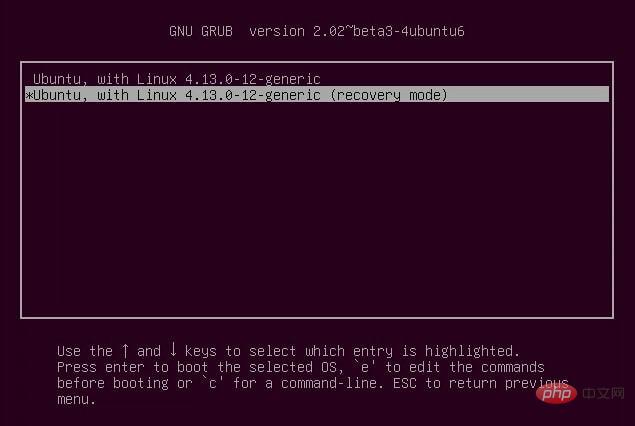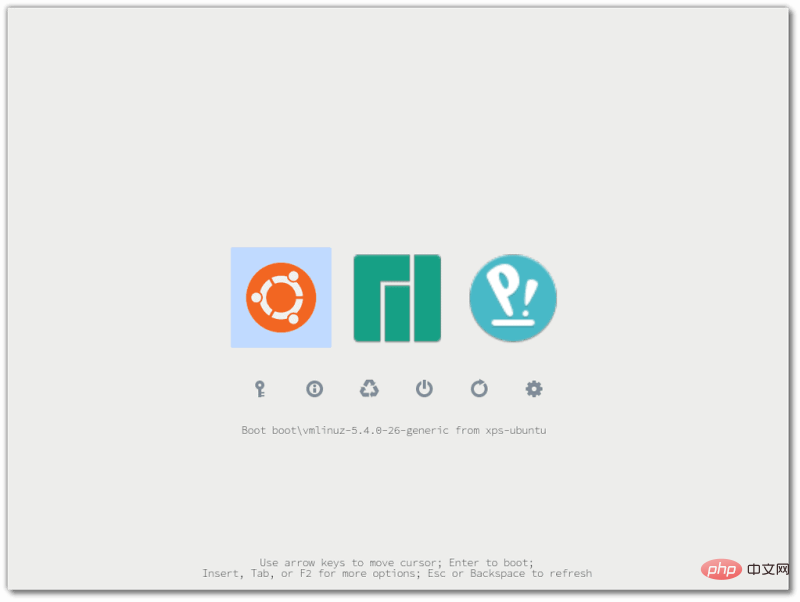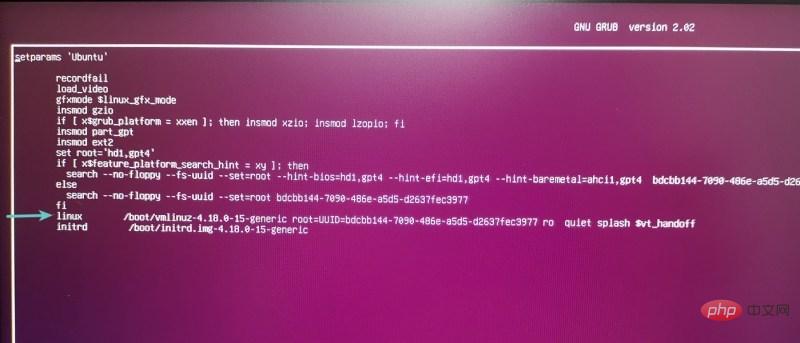what is linux grub
In Linux, grub is a complete program used to load and manage system startup. It is a boot program; it is the first software that runs when the computer starts, and loads the kernel of the operating system. It is up to the kernel to initialize other parts of the operating system. grub supports LBA, which puts the addressing translation used to find files into the hard drive's firmware.

The operating environment of this tutorial: Ubuntu 16.04 system, Dell G3 computer.
GRUB in Linux
GRUB is a complete program for loading and managing system startup. It is the most common bootloader in Linux distributions. The bootloader is very important because without it the operating system cannot be started.
The boot program is the first software that runs when the computer starts. The boot loader transfers control to the operating system kernel.
It loads the kernel of the operating system, and then the kernel initializes other parts of the operating system (including Shell, display manager, desktop environment, etc.).
GRUB is the default bootloader for many Linux distributions. This is because it is better than many previous versions of bootloaders. Some of its features are:
GRUB supports LBA (Logical Block Addressing Mode), which puts the addressing translation used to find files into the hard drive’s firmware
GRUB provides maximum flexibility to load the required options for the operating system using a command-based pre-operating system environment.
Boot options such as kernel parameters can be modified using the GRUB command line.
There is no need to specify the physical location of the Linux kernel for GRUB. It only requires the kernel's hard drive number, partition number and file name.
GRUB can start almost all operating systems using direct loading and chain loading startup methods.
Boot Program and Boot Manager
I don’t want to confuse you right now, but I think this topic It is inevitable. There is a blurry line between the boot loader and the boot manager.
You already know what a bootloader is. It starts first, then loads the kernel into memory and executes it. The boot manager allows you to choose between different operating systems (if you have more than one operating system on your computer). The boot manager does not load the system directly.
With the introduction of Linux kernel version 3.3, the Linux kernel includes a built-in EFI bootloader. In fact, any EFI-enabled system includes an EFI bootloader. In systems that support EFI, the firmware reads the EFI files in the EFI System Partition (ESP) to obtain boot information.
Insert a picture here, which shows the partition table with the ESP partition:

GRUB is both a boot program and a boot manager . I'll talk about GRUB in a moment. Let's first look at other GRUB-like programs.
Little knowledge: GRUB is the abbreviation of GRand Unified Bootloader.
GRUB What do those lines on the screen mean?
You will see a few lines on the GRUB screen. These lines will be different for different setups and different distributions.
Normally, the first line is your Linux distribution. If you see something like advanced options, you can go into it and find some lines that start with "linux-generic-x-y-z" etc.
When your Linux distribution updates a kernel version, it will keep at least one older version. You can choose to boot into an older Linux kernel in case your system encounters any issues with the newly updated Linux kernel.
In Ubuntu-based distributions, you may also see a recovery option.

At the end, you may see an entry such as System Settings or UEFI Settings to access your system's BIOS settings.
What other boot managers are similar to GRUB?
GRUB is the most popular boot manager in Linux. But it's not the only one. There is a highly customizable boot manager called rEFInd Boot Manager, which is also loved by some Linux users.

There is also a text-based boot manager called systemd-boot. As you can guess this is intended for systemd based Linux distributions. There are some distributions that are using systemd-boot, such as Pop OS.

Accessing or editing GRUB
Normally the GRUB screen you see is its menu interface. If you have more than one operating system installed, it will allow you to choose one to start. If your Linux distribution has more than one kernel installed, you can also choose to load a different kernel.
Depending on the configuration of different Linux distributions, there may be some other options on your GRUB menu.
You can press the e key in the GRUB menu interface to edit menu items. This way you can modify the parameters of the kernel before it is loaded. For example, in some cases, disabling the graphics driver provided by the kernel can help you solve the problem of Linux system getting stuck at startup.

You can also press the c key on the GRUB menu interface to enter the GRUB command line menu.
GRUB Configuration File
Any changes you make to GRUB in the menu interface are temporary. If you want to make some permanent changes to GRUB, such as changing the default timeout, you can modify the GRUB configuration file after the Linux system starts.
The default GRUB configuration file is /etc/default/grub. There is also a /etc/default/grub.d directory, which also stores some configurations. You can edit the /etc/default/grub file directly, but I recommend making additional modifications by adding configuration files (.cfg files) in this directory.
You must update GRUB for these changes to take effect.
Use the GRUB Customizer to customize GRUB
If you are not used to using a text editor to edit files in the terminal, you can use a A graphical tool called GRUB Customizer.
It allows you to change the startup sequence, default timeout, etc. You can also use it to set the GRUB background to a custom wallpaper.
The GRUB customizer can be installed from the Universe repository in Ubuntu 20.04 and via a PPA in Ubuntu 18.04. It is available in Arch Linux-based distributions via the AUR.
Related recommendations: "Linux Video Tutorial"
The above is the detailed content of what is linux grub. For more information, please follow other related articles on the PHP Chinese website!

Hot AI Tools

Undresser.AI Undress
AI-powered app for creating realistic nude photos

AI Clothes Remover
Online AI tool for removing clothes from photos.

Undress AI Tool
Undress images for free

Clothoff.io
AI clothes remover

AI Hentai Generator
Generate AI Hentai for free.

Hot Article

Hot Tools

Notepad++7.3.1
Easy-to-use and free code editor

SublimeText3 Chinese version
Chinese version, very easy to use

Zend Studio 13.0.1
Powerful PHP integrated development environment

Dreamweaver CS6
Visual web development tools

SublimeText3 Mac version
God-level code editing software (SublimeText3)

Hot Topics
 1378
1378
 52
52
 How to start nginx in Linux
Apr 14, 2025 pm 12:51 PM
How to start nginx in Linux
Apr 14, 2025 pm 12:51 PM
Steps to start Nginx in Linux: Check whether Nginx is installed. Use systemctl start nginx to start the Nginx service. Use systemctl enable nginx to enable automatic startup of Nginx at system startup. Use systemctl status nginx to verify that the startup is successful. Visit http://localhost in a web browser to view the default welcome page.
 How to check whether nginx is started
Apr 14, 2025 pm 01:03 PM
How to check whether nginx is started
Apr 14, 2025 pm 01:03 PM
How to confirm whether Nginx is started: 1. Use the command line: systemctl status nginx (Linux/Unix), netstat -ano | findstr 80 (Windows); 2. Check whether port 80 is open; 3. Check the Nginx startup message in the system log; 4. Use third-party tools, such as Nagios, Zabbix, and Icinga.
 How to solve nginx403
Apr 14, 2025 am 10:33 AM
How to solve nginx403
Apr 14, 2025 am 10:33 AM
How to fix Nginx 403 Forbidden error? Check file or directory permissions; 2. Check .htaccess file; 3. Check Nginx configuration file; 4. Restart Nginx. Other possible causes include firewall rules, SELinux settings, or application issues.
 How to start nginx server
Apr 14, 2025 pm 12:27 PM
How to start nginx server
Apr 14, 2025 pm 12:27 PM
Starting an Nginx server requires different steps according to different operating systems: Linux/Unix system: Install the Nginx package (for example, using apt-get or yum). Use systemctl to start an Nginx service (for example, sudo systemctl start nginx). Windows system: Download and install Windows binary files. Start Nginx using the nginx.exe executable (for example, nginx.exe -c conf\nginx.conf). No matter which operating system you use, you can access the server IP
 How to check whether nginx is started?
Apr 14, 2025 pm 12:48 PM
How to check whether nginx is started?
Apr 14, 2025 pm 12:48 PM
In Linux, use the following command to check whether Nginx is started: systemctl status nginx judges based on the command output: If "Active: active (running)" is displayed, Nginx is started. If "Active: inactive (dead)" is displayed, Nginx is stopped.
 How to solve nginx403 error
Apr 14, 2025 pm 12:54 PM
How to solve nginx403 error
Apr 14, 2025 pm 12:54 PM
The server does not have permission to access the requested resource, resulting in a nginx 403 error. Solutions include: Check file permissions. Check the .htaccess configuration. Check nginx configuration. Configure SELinux permissions. Check the firewall rules. Troubleshoot other causes such as browser problems, server failures, or other possible errors.
 How to solve nginx304 error
Apr 14, 2025 pm 12:45 PM
How to solve nginx304 error
Apr 14, 2025 pm 12:45 PM
Answer to the question: 304 Not Modified error indicates that the browser has cached the latest resource version of the client request. Solution: 1. Clear the browser cache; 2. Disable the browser cache; 3. Configure Nginx to allow client cache; 4. Check file permissions; 5. Check file hash; 6. Disable CDN or reverse proxy cache; 7. Restart Nginx.
 How to clean nginx error log
Apr 14, 2025 pm 12:21 PM
How to clean nginx error log
Apr 14, 2025 pm 12:21 PM
The error log is located in /var/log/nginx (Linux) or /usr/local/var/log/nginx (macOS). Use the command line to clean up the steps: 1. Back up the original log; 2. Create an empty file as a new log; 3. Restart the Nginx service. Automatic cleaning can also be used with third-party tools such as logrotate or configured.






